The grant scheme launched on the 30th of September and will see homeowners and landlords in England to get vouchers worth up to £10,000 to help carry out renovations to make their homes more energy-efficient.
‘From September, homeowners and landlords will be able to apply for vouchers to make their homes more energy-efficient and create local jobs. The grants will cover at least two-thirds of the costs, up to £5,000 per household,’ Sunak announced during the briefing.
Households with the lowest income in England can receive a voucher of up to £10,000, covering the full cost of renovations.
The renovations are split up into two categories: primary and secondary measures.
The Green Homes Grant was extended until 31 March 2022 and will receive additional funding of £1bn, according to Boris Johnson’s Ten Point Plan that was revealed on 18 Nov 2020. But this deadline has since been changed again, and the deadline for new applications was set at the end of March 2021.
What Other Government Grants Are Available in the UK?
Even though the UK government closed the Green Homes Grant, there are alternative grants and incentives that are available to UK households. The following grants are available in the UK for installing low carbon and clean energy technologies:
- Renewable Heat Incentive (RHI) – RHI is a scheme designed to help and incentivize homes that make use of renewable energy heating technologies such as heat pumps. When you’ve installed a renewable heating technology, you will be eligible to apply for RHI with which you could earn quarterly payment for a period of 7 years. It is said that the Clean Heat Grant which is a new proposal is expected to replace RHI after March 2022.
- Smart Export Guarantee (SEG) – The Smart Export Guarantee incentivises UK homes that have installed renewable energy technologies like solar panels to generate electricity for their homes. With SEG, you can sell the surplus energy generated by the renewable technology back to the grid and earn money.
- Energy Company Obligation (ECO) – The ECO is a government energy efficiency initiative to lower carbon emissions by supporting low income and vulnerable households to heat their home.
- VAT Reduction – With this scheme, certain households with solar panels can get a 5% tax reduction under the new VAT pricing system for the installation of energy-saving technologies.
What Is Covered by the Green Homes Grant?
The complete list has now been released by the government and covers a variety of energy-saving improvements. There are two categories of renovations: primary and secondary measures.
The government urges suppliers of the below-mentioned improvements to sign up for TrustMark or MCS accreditation in order to take part in this scheme.
 1 2 3 4 5 6 7 8 9
1 2 3 4 5 6 7 8 9 Primary Measures
You can apply for one or more of the primary home renovation projects under the Green Homes Grant.
You cannot claim the voucher for work that has already been carried out. That is to say, you cannot claim a voucher for a heat pump you have already installed prior to the launch of the grant — it must be carried out during the period of the grant. You may, however, use the voucher to top up your existing installations, such as upgrading old windows to new windows.
The following energy-saving projects are covered:
When it comes to low carbon heating measures, it is important that they replace an existing fossil-fuelled system—except when it comes to solar thermal panels.
Secondary Measures
Secondary renovations are only possible if at least one primary measure is carried out.
Moreover, you only qualify for secondary measures if you are upgrading to these measures—for example, if you already have double glazed windows you cannot qualify for new double glazed windows.
- Upgrading to double glazing
- Upgrading to secondary glazing
- Upgrading to triple glazing
- Upgrading to draught-proof doors (when replacing doors that have been installed prior to 2002)
- Upgrading to draught-proof windows
- Heating controls
- Hot water tank/appliance tank thermostats/smart meters for heating.
The costs of the secondary measures cannot exceed the costs of the primary measures.
According to estimates from the Treasury, families can save as much as £300 per year through the Green Homes grant by reducing their energy bills with these measures.
In order to participate in the scheme, homeowners can apply online from September onward, and will receive a redeemable voucher that they can then use with accredited partners.
What Is Not Covered by the Scheme?
The Green Homes Grant covers a variety of green home improvements, but there are certain works that it does not cover. The overall aim of the scheme is to make homes more energy-efficient, and any works that do not relate to this will not qualify you for a voucher.
The following is not covered by the Green Homes Grant:
- Any renovation that was carried out prior to a voucher being issued
- Any type of renovation that does not improve a home’s energy efficiency
- Boiler replacements or repairs
- Building a new extension to your home
- Insulating extensions or conservatories that do not have fixed heating installed
In addition, it is worth noting that solar panels (photovoltaic panels) are not included in the Green Homes Grant. It is only solar thermal panels that are included.
Who Is Eligible for the Green Homes Grant?
To be eligible for the grant, your home must be in England. The application has to be filled out by 31 March 2021.
In order to qualify, you must either:
- be the owner of your own home, or
- be a private or social landlord (landlords are not eligible for the low-income part of the grant scheme)
Newly-built properties that have not been occupied previously are not eligible under the Green Homes Grant.
Do I Qualify for the Low-Income Portion of the Scheme?
Under the low-income part of the scheme, the government may pay for 100% of the installation costs of your renovations—or up to £10,000. In addition, you won’t be asked to pay a deposit for your renovations.
In addition to the Green Homes Grant scheme, Surrey County Council announced top-up funding called Green Jump Surrey to the projects, which is available to some customers depending on their individual circumstances.
This new funding will provide eligible households with up to £10,000 for energy efficiency measures in Surrey homes, and can be availed until 31st March 2021. The project covers the full cost of works up to a value of £15,000.
To qualify, you or anyone in your household must be on certain benefits.
The full list of benefits can be found on the government’s website.
Can I Combine the Green Homes Grant with other Grants?
If you received a grant under the Local Authority Delivery scheme, you are not eligible.
If you already received a grant for the same measure under the Energy Company Obligation (ECO) grant, you cannot use a Green Homes Grant voucher for that same measure.
For example, if you used the ECO grant for draught-proof windows, you may not use a Green Homes Grant voucher for windows too, though you may use it for draught-proofing your doors.
You can receive both the Green Homes Grant and the domestic Renewable Heat Incentive (RHI). You will first need to claim the voucher, then notify Ofgem, so they can deduct the amount of the voucher from your RHI payments. This means that you will, in effect, pay off the voucher through your RHI payments, meaning you won’t reap the full benefits of the RHI.
How to Apply For Green Homes Grant?
To apply for the Green Homes Grant, you first need to get a quote from a TrustMark or MCS accredited installer that has approved the work for your particular property. It’s recommended to get three quotes, so you can be sure you get the best offer.
Once you have received a quote, you can apply for a voucher on the government’s website.
The following details are required when you apply:
- Personal information of the property owner(s)
- Personal information of those living on the property that is currently receiving benefits
- The quote you received from the MCS or TrustMark accredited installer
- The TrustMark license number of the installer
Note: The TrustMark certified installer can use subcontractors to carry out works. In an effort to make the grant more accessible, the government has announced that subcontractors do not need to be MCS or TrustMark certified.
If one or more of the quotes you have received is unreasonably high, it will not be approved by the Green Homes Grant team. This is to ensure fair pricing amongst installers. In this case, you may need to seek another quote that is reasonably priced, or, if you submitted multiple quotes in your application, the cheapest one (if it is reasonable) will be selected.
If you are carrying out multiple projects, you don’t need to complete a separate application for each of them; simply submit the individual quotes as one application. You will then receive separate vouchers for each measure.
You cannot redeem vouchers for works that have already started. Do not start a project until the voucher has been approved.
If you plan to carry out a secondary measure, you must first have completed the primary measure and redeemed that voucher, in order to be able to redeem the secondary measure voucher.
How to Ensure You Can Redeem the Voucher
Once the voucher has been issued, it is valid for three months.
Once the work has been completed, you will need to provide the following information:
- Satisfactory completion of the project before expiry of the voucher.
- All necessary documentation from the installer regarding the project, including a dated copy of the invoice
- Proof that you have paid for your share of the costs to the installer (unless you are part of the low-income portion of the scheme)
- Proof that you meet the eligibility requirements of the scheme
When you redeem the voucher, the remaining costs of the project will be paid directly to the installer. This will complete the project and you can then enjoy your new green energy home improvement.
What the Grant Aims to Achieve
The Green Homes Grant scheme is a £3 billion package to help the UK bounce back from the COVID-19 pandemic by saving money, cutting carbon, and creating jobs. A further £1 billion package for the public sector was announced by Mr Sunak.
On the 18th of November 2020, Boris Johnson announced that an additional £1bn will be allocated to the grant scheme.
In total, this £4 billion initiative by the government will make 650,000 homes in England more energy efficient, help save households money on bills, lower the UK’s carbon emission by more than half a mega tonne per year — equivalent to taking 270,000 cars off the road — and support an estimated 140,00 green jobs.
‘This is going to be a green recovery with concern for our environment at its heart,’ Sunak says.
Together with existing funding opportunities for green energy, a £5,000 voucher makes the switch to renewables more affordable than ever.
Compare the best offers for green energy improvements for your home through GreenMatch’s quote comparison service.





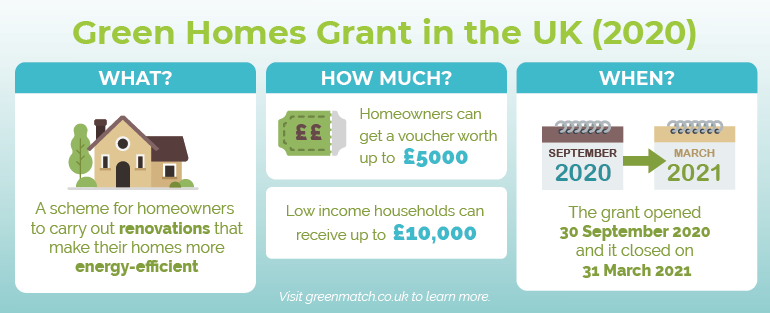
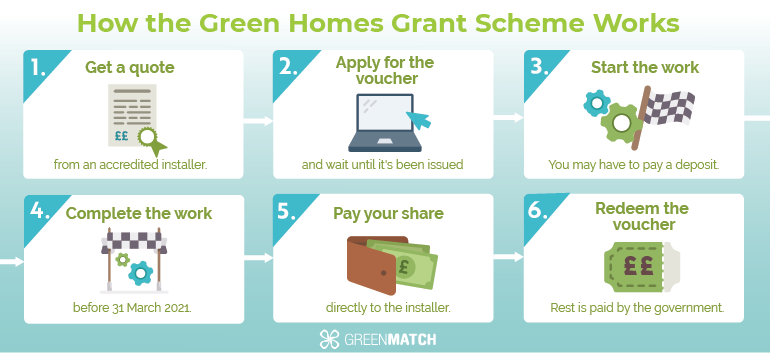

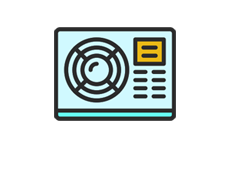


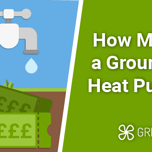

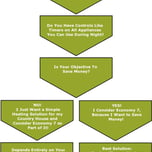
 We strive to connect our customers with the right product and supplier. Would you like to be part of GreenMatch?
We strive to connect our customers with the right product and supplier. Would you like to be part of GreenMatch?